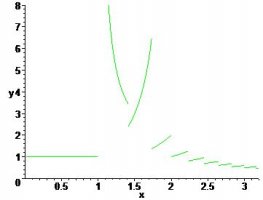You are using an out of date browser. It may not display this or other websites correctly.
You should upgrade or use an alternative browser.
You should upgrade or use an alternative browser.
inquality
- Thread starter chrislav
- Start date
the problem is clear it demands the existence of a B>0 It does not demant the existence of a B between 0 and 1 .If the B is greater than 1 is still gtreater that zeroI take it you mean A > 0 rather than A > O.
Is it not obvious that if 0 < B < 1, the problem cannot be solved? If B < 1, then x = 1 is supposedly possible, which entails that the left hand expression is not a real number.
Yes. But you missed my point entirely.the problem is clear it demands the existence of a B>0 It does not demant the existence of a B between 0 and 1 .If the B is greater than 1 is still gtreater that zero
[math]0 < B < 1 \implies 1 > B.[/math]
The problem says that the indicated expression is less than some (presumably finite) number for ALL x > B. That is false if x = 1. Therefore, you can work from the assumption that [imath]B \ge 1.[/imath]
I am dubious that we have the problem correctly specified.
[math]0 < x < 1 \implies 0 < x^2 < 1 \implies \lfloor x^2 \rfloor = 0 \implies \dfrac{x}{x - \lfloor x^2 \rfloor} = 1.[/math]
So there can be no B that makes the statement true if A = 0.25.
Please give the wording of the problem completely and exactly.
[math]0 < x < 1 \implies 0 < x^2 < 1 \implies \lfloor x^2 \rfloor = 0 \implies \dfrac{x}{x - \lfloor x^2 \rfloor} = 1.[/math]
So there can be no B that makes the statement true if A = 0.25.
Please give the wording of the problem completely and exactly.
given A=0.25 put B=6 (B=5 is the lowest value)I am dubious that we have the problem correctly specified.
[math]0 < x < 1 \implies 0 < x^2 < 1 \implies \lfloor x^2 \rfloor = 0 \implies \dfrac{x}{x - \floor x^2 \rfloor} = 1.[/math]
So there can be no B that makes the statement true if A = 0.25.
Please give the wording of the problem completely and exactly.
then for all x>6 :[math]|\frac{x}{x-\lfloor x^2\rfloor}|<0.25[/math]
the x>0 is superfluous since x>B>0 implies x>0Given A>O find B>0 such that :
For all x>0 and x>B then [math]|\frac{x}{x-\lfloor x^2\rfloor}|<A[/math]Without using the concept of the limit
Here i dont know how even to start

